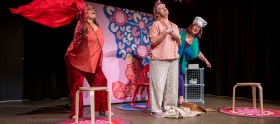Ira Glass in Three Acts, Two Dancers and One Radio Photograph by Daniel Boud.
A dancer clings to her partner; both are perched precariously atop a breakfast table. Fragility and strength interlace in this tender domestic scene. The vignette adds poignancy and beauty to the words of American poet Donald Hall, who reflects on caring for his wife in the last days of her battle with leukaemia. Soon after, one of the world’s most successful radio hosts, Ira Glass, gleefully indulges his craft of animal balloonery and joyously counts the eight times he’s just said the word ‘dick’ on the stage of the Sydney Opera House. Like the 20 year-old podcast This American Life, Three Acts, Two Dancers and One Radio Host balances profundity with playfulness to enrich and entertain its audience.
Three Acts is a collaboration between Glass and dancers Monica Bill Barnes and Anna Bass, and has been touring on and off for three years. Billed as a show which combines two art forms ‘which have no business being together’, the pairing actually makes perfect sense. Glass has said “what makes it work is a shared sensibility”. Over 90 minutes of dance and audio on themes of love, loss and creative collaboration, the shared humour, goofiness, and deep love of good storytelling are out, loud, and proud.
At its best, the show interweaves the two mediums to great effect. As we watch the two dancers side by side in tightly choreographed unison, we tune into Anna’s thoughts in an interview with Ira about the“healthy competition” of her dance partnership with Monica. As Ira muses on the challenges of performers repeating the same motions ad nauseam in a story about a Riverdance troupe, we see Anna and Monica’s movements in an amusing new light.
Perhaps being a victim of its own success, I did find myself wishing for more of these moments. In an effort to emphasise the effervescent energy of the hugely talented dancers and to give This American Life fans what they came for – some time alone with Ira Glass – the interaction between art forms was underplayed.
Still, this is a minor grumble in a show that never lacks for humour, energy, warmth and generosity of spirit. Monica Bill Barnes, Anna Bass and Ira Glass draw together the strengths of a medium without words and a medium without movement in the service of artful storytelling.
Three Acts embodies the essence of the beloved radio show and enhances it with physical performances of great power and beauty.
Rating: 3.5 stars out of 5
Ira Glass, Monica Bill Barnes, Anna Bass: Three Acts, Two Dancers, One Radio Host
Director/Choreographer: Monica Bill Barnes
Lighting Designer: Jane Cox
Costume/Set Designer: Kelly Hanson
Creative Producing Director: Robert Saenz de Viteri
Cast: Anna Bass, Monica Bill Barnes, Ira Glass
Sydney Opera House
17 and 18 July 2016






